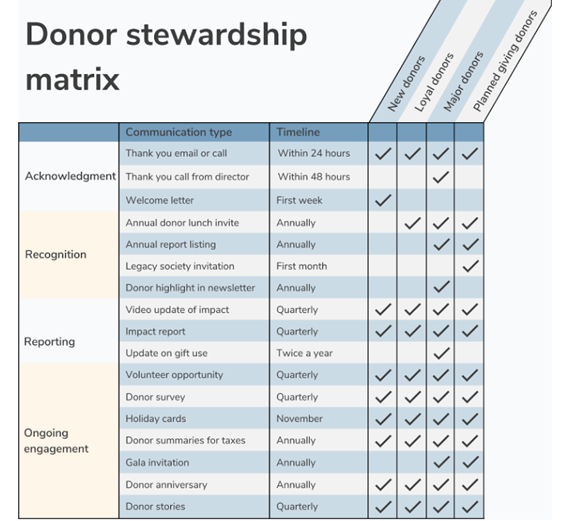Unlocking The Secrets To Donor Stewardship

Keeping donors engaged is one of the most important yet challenging tasks for nonprofits. It’s a heavy lift that requires a pipeline of content and resources to stay top of mind so you can earn your share of wallet. Donor stewardship, however, is an investment worth making as it’s an investment in the sustainability of your organization. The secret to success is developing a stewardship strategy that maximizes the resources you have available.
What is Donor Stewardship?
Donor stewardship is the act of cultivating long-lasting relationships with donors to increase your organization’s donor retention rate. Donor retention measures how many donors continue to donate to your organization over time. It’s common for nonprofits to have more first-time donors than recurring. But getting new donors are twice the work of upgrading existing ones. That’s not to say that you shouldn’t have a strategy to attract new donors. But crafting a donor stewardship strategy that nurtures donors into giving more produces the lowest hanging fruit.
An effective donor stewardship strategy taps into your donors’ “why.” Understanding donor motivation positions your organization to deliver experiences that meet donor expectations while benefiting your cause.
Still, many nonprofits struggle to transition first-time givers into recurring donors. To make matters worse, the national average for donor attrition has been hovering at 55% for over a decade. A dismal statistic considering most donor acquisition appeals yield less than 1% in returns.
That’s why developing a donor stewardship strategy is essential. By doing so, you can boost engagement across your donor pipeline, nurture first-time givers into repeat donors, and hopefully convert repeat donors into lifelong brand ambassadors.
One of your stewardship strategy’s most important components lies in a human tradition as old as time – communication. When organizations go silent, donors go dormant. But blanket communication doesn’t work. Let’s take a look at the power of personalization.
Segment Donors to Personalize Communication
Segmentation, or the practice of separating data based on shared characteristics, enables you to create content relevant to that segment of the donor set, thus making an audience of a thousand feel like an audience of one.
By segmenting your donors into categories like new donors (small one-time gifts), LYBUNTs (last year but unfortunately not this year donors), and SYBUNTS (some year but unfortunately not this year donors), you can communicate with your donor base in ways that are more meaningful and effective. This facilitates deeper connections and more personalized experiences. About 60% of today’s donors say personalized experiences would motivate them to increase gift-giving by 10%.
Develop a Donor Stewardship Matrix
Now that you’ve segmented your data, it’s time to steer your donors down a targeted communication funnel using the donor stewardship matrix.
Much like it sounds, the donor stewardship matrix (also referred to as the donor stewardship plan) is a tool that allows you to map out your communication plan visually. In each phase of engagement, you see the type of communication (thank you emails, welcome letters, donor surveys, etc.) and timelines for execution and coordinate them with your donor segments.
This is particularly valuable for mid-level donors who are often overlooked and neglected. The tool keeps correspondence organized across donor outreach efforts. It also helps you visually create more donor touchpoints, opening up opportunities to make repeat yet timely asks.

Utilizing the donor stewardship matrix also helps solidify your brand identity in the minds of your donors, including your values. This leads to greater awareness and more opportunities to cultivate donor loyalty.
Leverage Key Concepts to Increase Donor Delight
Lastly, keep a few key concepts in mind as you develop your donor stewardship strategy to elevate your donor experience, such as:
- Your donors want to feel like their contributions matter. In your gratitude campaigns, send individual impact reports, extend opportunities to fellowship with your board, other donors, and program beneficiaries. Donors want to see their impact at work.
- Timeliness is essential to retaining your donors’ attention and is a critical aspect of making a second ask. If your donors reach out to your organization via social media, for example, reply within the first 24 hours.
- Chart your follow-up response for each action item in your donor stewardship matrix. For example, if a member of your “new donors” group makes a second gift, what does post-donation follow-up look like? Map it out.
- Put systems in place to execute your donor stewardship strategy. Include the technology needed and staff capacity required to accomplish your goals. Assign tasks, dates, and reminders using project management tools like Trello or Monday to keep team members organized and on top of daily assignments.
Key Takeaways
Donor stewardship is a fundamental aspect of developing donor relationships, increasing donor retention rates, and generating revenue. But getting the right pieces in place requires a well-formulated plan and coordination across teams. By segmenting donors, utilizing the donor stewardship matrix tool, and taking a donor-centric approach to enabling delight, you foster an environment for ongoing communication with donors that can lead to increased engagement and financial support over time.






